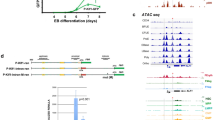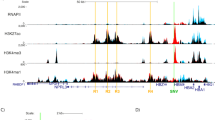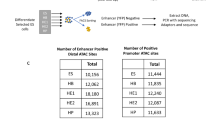Abstract
Many genes determining cell identity are regulated by clusters of Mediator-bound enhancer elements collectively referred to as super-enhancers. These super-enhancers have been proposed to manifest higher-order properties important in development and disease. Here we report a comprehensive functional dissection of one of the strongest putative super-enhancers in erythroid cells. By generating a series of mouse models, deleting each of the five regulatory elements of the α-globin super-enhancer individually and in informative combinations, we demonstrate that each constituent enhancer seems to act independently and in an additive fashion with respect to hematological phenotype, gene expression, chromatin structure and chromosome conformation, without clear evidence of synergistic or higher-order effects. Our study highlights the importance of functional genetic analyses for the identification of new concepts in transcriptional regulation.
This is a preview of subscription content, access via your institution
Access options
Subscribe to this journal
Receive 12 print issues and online access
$209.00 per year
only $17.42 per issue
Buy this article
- Purchase on Springer Link
- Instant access to full article PDF
Prices may be subject to local taxes which are calculated during checkout






Similar content being viewed by others
Accession codes
References
Whyte, W.A. et al. Master transcription factors and mediator establish super-enhancers at key cell identity genes. Cell 153, 307–319 (2013).
Lovén, J. et al. Selective inhibition of tumor oncogenes by disruption of super-enhancers. Cell 153, 320–334 (2013).
Hnisz, D. et al. Super-enhancers in the control of cell identity and disease. Cell 155, 934–947 (2013).
Ing-Simmons, E. et al. Spatial enhancer clustering and regulation of enhancer-proximal genes by cohesin. Genome Res. 25, 504–513 (2015).
Qian, J. et al. B cell super-enhancers and regulatory clusters recruit AID tumorigenic activity. Cell 159, 1524–1537 (2014).
Siersbæk, R. et al. Transcription factor cooperativity in early adipogenic hotspots and super-enhancers. Cell Rep. 7, 1443–1455 (2014).
Vahedi, G. et al. Super-enhancers delineate disease-associated regulatory nodes in T cells. Nature 520, 558–562 (2015).
Pott, S. & Lieb, J.D. What are super-enhancers? Nat. Genet. 47, 8–12 (2015).
Heintzman, N.D. et al. Distinct and predictive chromatin signatures of transcriptional promoters and enhancers in the human genome. Nat. Genet. 39, 311–318 (2007).
Kvon, E.Z. Using transgenic reporter assays to functionally characterize enhancers in animals. Genomics 106, 185–192 (2015).
Hosseini, M. et al. Causes and consequences of chromatin variation between inbred mice. PLoS Genet. 9, e1003570 (2013).
Creyghton, M.P. et al. Histone H3K27ac separates active from poised enhancers and predicts developmental state. Proc. Natl. Acad. Sci. USA 107, 21931–21936 (2010).
Rada-Iglesias, A. et al. A unique chromatin signature uncovers early developmental enhancers in humans. Nature 470, 279–283 (2011).
Kowalczyk, M.S. et al. Intragenic enhancers act as alternative promoters. Mol. Cell 45, 447–458 (2012).
Dowen, J.M. et al. Control of cell identity genes occurs in insulated neighborhoods in mammalian chromosomes. Cell 159, 374–387 (2014).
Hughes, J.R. et al. Annotation of cis-regulatory elements by identification, subclassification, and functional assessment of multispecies conserved sequences. Proc. Natl. Acad. Sci. USA 102, 9830–9835 (2005).
Pennacchio, L.A. et al. In vivo enhancer analysis of human conserved non-coding sequences. Nature 444, 499–502 (2006).
Kothary, R. et al. Inducible expression of an hsp68-lacZ hybrid gene in transgenic mice. Development 105, 707–714 (1989).
Anguita, E. et al. Deletion of the mouse α-globin regulatory element (HS −26) has an unexpectedly mild phenotype. Blood 100, 3450–3456 (2002).
Dölken, L. et al. High-resolution gene expression profiling for simultaneous kinetic parameter analysis of RNA synthesis and decay. RNA 14, 1959–1972 (2008).
Geiss, G.K. et al. Direct multiplexed measurement of gene expression with color-coded probe pairs. Nat. Biotechnol. 26, 317–325 (2008).
Davies, J.O.J. et al. Multiplexed analysis of chromosome conformation at vastly improved sensitivity. Nat. Methods 13, 74–80 (2016).
Thurman, R.E. et al. The accessible chromatin landscape of the human genome. Nature 489, 75–82 (2012).
Shen, Y. et al. A map of the cis-regulatory sequences in the mouse genome. Nature 488, 116–120 (2012).
Grosveld, F., van Assendelft, G.B., Greaves, D.R. & Kollias, G. Position-independent, high-level expression of the human β-globin gene in transgenic mice. Cell 51, 975–985 (1987).
Parker, S.C. et al. Chromatin stretch enhancer states drive cell-specific gene regulation and harbor human disease risk variants. Proc. Natl. Acad. Sci. USA 110, 17921–17926 (2013).
Huang, J. et al. Dynamic control of enhancer repertoires drives lineage and stage-specific transcription during hematopoiesis. Dev. Cell 36, 9–23 (2016).
Bender, M.A. et al. The hypersensitive sites of the murine β-globin locus control region act independently to affect nuclear localization and transcriptional elongation. Blood 119, 3820–3827 (2012).
Frankel, N. et al. Phenotypic robustness conferred by apparently redundant transcriptional enhancers. Nature 466, 490–493 (2010).
Perry, M.W., Boettiger, A.N., Bothma, J.P. & Levine, M. Shadow enhancers foster robustness of Drosophila gastrulation. Curr. Biol. 20, 1562–1567 (2010).
Hong, J.W., Hendrix, D.A. & Levine, M.S. Shadow enhancers as a source of evolutionary novelty. Science 321, 1314 (2008).
Villar, D. et al. Enhancer evolution across 20 mammalian species. Cell 160, 554–566 (2015).
Buenrostro, J.D., Giresi, P.G., Zaba, L.C., Chang, H.Y. & Greenleaf, W.J. Transposition of native chromatin for fast and sensitive epigenomic profiling of open chromatin, DNA-binding proteins and nucleosome position. Nat. Methods 10, 1213–1218 (2013).
Langmead, B., Trapnell, C., Pop, M. & Salzberg, S.L. Ultrafast and memory-efficient alignment of short DNA sequences to the human genome. Genome Biol. 10, R25 (2009).
McGowan, S.J., Hughes, J.R., Han, Z.P. & Taylor, S. MIG: Multi-Image Genome viewer. Bioinformatics 29, 2477–2478 (2013).
Heinz, S. et al. Simple combinations of lineage-determining transcription factors prime cis-regulatory elements required for macrophage and B cell identities. Mol. Cell 38, 576–589 (2010).
Engler, C., Gruetzner, R., Kandzia, R. & Marillonnet, S. Golden gate shuffling: a one-pot DNA shuffling method based on type IIs restriction enzymes. PLoS One 4, e5553 (2009).
Sauka-Spengler, T. & Barembaum, M. Gain- and loss-of-function approaches in the chick embryo. Methods Cell Biol. 87, 237–256 (2008).
Mao, X., Fujiwara, Y. & Orkin, S.H. Improved reporter strain for monitoring Cre recombinase–mediated DNA excisions in mice. Proc. Natl. Acad. Sci. USA 96, 5037–5042 (1999).
Fiering, S. et al. Targeted deletion of 5HS2 of the murine β-globin LCR reveals that it is not essential for proper regulation of the β-globin locus. Genes Dev. 9, 2203–2213 (1995).
Russell, E.S. & Berstein, S.E. in Biology of the Laboratory Mouse 2nd edn. (ed. Green, E.L.) Chapter 17 (Dover Publications, 1966).
Kent, W.J. et al. The human genome browser at UCSC. Genome Res. 12, 996–1006 (2002).
Feng, J., Liu, T., Qin, B., Zhang, Y. & Liu, X.S. Identifying ChIP-seq enrichment using MACS. Nat. Protoc. 7, 1728–1740 (2012).
Acknowledgements
This manuscript is dedicated to the memory of Professor Bill Wood who initiated the project and died in 2014 during the course of this work. The work was supported by the Wellcome Trust (D.H.), the UK Medical Research Council (MRC) and the National Institute for Health Research Biomedical Research Centre, Oxford. L.A.P. was supported by NIDCR FaceBase grant U01DE020060NIH and by NHGRI grants R01HG003988 and U54HG006997, and research was conducted at the E.O. Lawrence Berkeley National Laboratory and performed under US Department of Energy contract DE-AC02-05CH11231, University of California.
Author information
Authors and Affiliations
Contributions
D.R.H. and W.G.W. conceived the project. D.R.H., J.R.H., D.H., J.O.J.D., L.L.P.H., M.C.S. and J.T. designed experiments. J.R.H., C.B., D.H., J.O.J.D., B.J.G., L.L.P.H., M.T.K., J.A.S., M.C.S., J.T., R.W., P.-S.L., J.A.S.-S., H.A., A.M.O., C.R. and S.B. performed experiments. D.R.H., J.R.H., C.B., D.H., J.O.J.D., B.J.G., L.L.P.H., M.T.K., M.C.S., J.T., R.W., J.A.S., A.M.O. and P.-S.L. analyzed data. D.R.H., J.R.H., C.B., D.H., J.O.J.D., B.J.G., L.L.P.H., M.T.K., M.C.S., J.T., R.W. and J.A.S. wrote the manuscript. L.A.P., A.J.H.S. and T.S.-S. provided reagents and expertise. D.R.H., J.R.H., R.J.G. and A.J.H.S. provided supervision.
Corresponding author
Ethics declarations
Competing interests
The authors declare no competing financial interests.
Supplementary information
Supplementary Text and Figures
Supplementary Figures 1–7 and Supplementary Tables 1–6. (PDF 47502 kb)
Circulating blood cells show R1 enhancer activity.
R1 enhancer activity in circulating blood cells, captured using a Red Epic camera attached to an Olympus MVX10 microscope, recorded at 240 frames per second at 1,280 iso, 20× magnification. (MP4 1799 kb)
Rights and permissions
About this article
Cite this article
Hay, D., Hughes, J., Babbs, C. et al. Genetic dissection of the α-globin super-enhancer in vivo. Nat Genet 48, 895–903 (2016). https://doi.org/10.1038/ng.3605
Received:
Accepted:
Published:
Issue Date:
DOI: https://doi.org/10.1038/ng.3605
This article is cited by
-
A distant global control region is essential for normal expression of anterior HOXA genes during mouse and human craniofacial development
Nature Communications (2024)
-
Cell-specific and shared regulatory elements control a multigene locus active in mammary and salivary glands
Nature Communications (2023)
-
A multiple super-enhancer region establishes inter-TAD interactions and controls Hoxa function in cranial neural crest
Nature Communications (2023)
-
Integrated single-cell chromatin and transcriptomic analyses of human scalp identify gene-regulatory programs and critical cell types for hair and skin diseases
Nature Genetics (2023)
-
On-microscope staging of live cells reveals changes in the dynamics of transcriptional bursting during differentiation
Nature Communications (2022)



